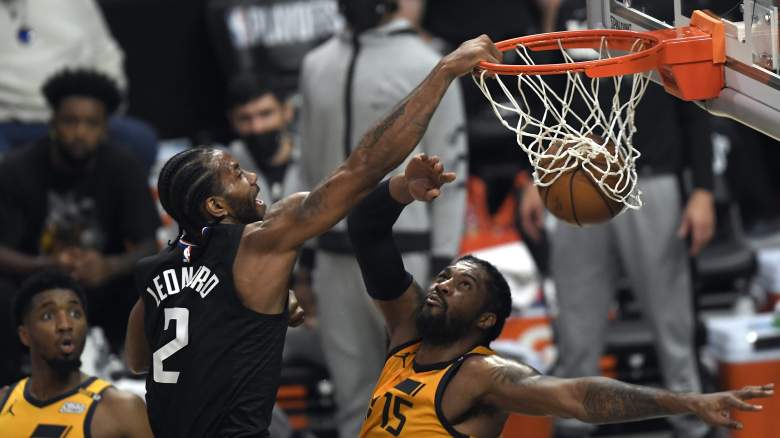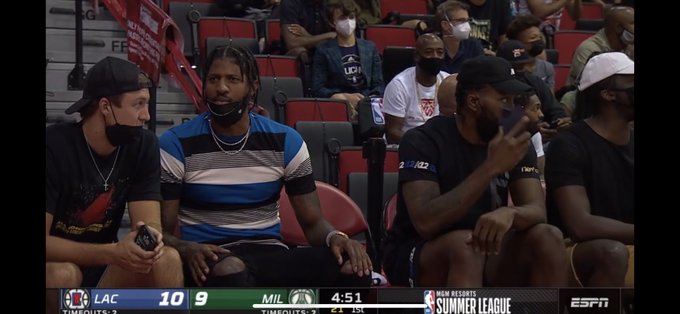
Getty Kawhi Leonard, in healthier times
For many months, well before his ACL injury and even after he opted out of his final contract year on August 1, 30-year-old Kawhi Leonard had been expected to re-sign with the L.A. Clippers. And that’s precisely what he did — this week inking a 4-year, $176 million deal with a player option for the fourth season. Yahoo! Sports’ Chris Haynes first reported Leonard’s intentions on August 6.
The signs were there. A new home in the Pacific Palisades, scant reports of discussions with other teams, the general unwillingness of one anonymous executive after another to suggest he would leave. Though maybe the surest signal was the sight of the normally anti-social Leonard occupying front-row seats at L.A.’s summer league. That’s probably not happening with a player ready to hit the road.
The reasons were there, too, for the L.A. native. Paul George, who Leonard enticed into forcing a trade from OKC in 2019, signed a max extension with the Clippers in late 2020. Leaving now, months after a conference finals appearance, could feel like something nearing betrayal. Free agents Reggie Jackson and Nicolas Batum, both of whom turned lemons in lemonade last season, also re-signed. Veteran tough guys Marcus Morris and Patrick Beverley are back, as is rising star Terance Mann. 24-year-old Ivica Zubac will look to build on his best season yet, and the guy he replaced at starting center, Serge Ibaka, who was Leonard’s teammate in Toronto, is hellbent on redemption after overdue back surgery in June.
Which is to say, the key pieces from last season are returning — a rarity in this day and age. (According to Spotrac, with all but a couple of medium-sized fish spoken for, L.A., Dallas and Cleveland are the only teams in the league who have yet to lose anyone to free agency). And surely Leonard also understood that no one else could pay him what the Clippers could. So coming back was not a tough leap.
Where things get interesting, is how he came back. While there were various ways for him to get paid handsomely, Leonard opted for a more secure but less lucrative route. Was it a sense of camaraderie and team chemistry that dictated his decision, or does it speak to how he feels about returning from major knee surgery?
On Thursday evening, hours after The Atheltic’s Shams Charania tweeted the total amount of Leonard’s deal, ESPN’s Bobby Marks, formerly assistant general manager of the Brooklyn Nets, took to Twitter to look at some of the available routes Leonard passed on.
Of course, one should always be hesitant to kick $176 million out of bed, but it did mean leaving the equivalent of a few Southern California mansions on the table. Obviously, his surgery played a role in his choice.
Marks points out that had Leonard simply opted-in to the $36 million for 2021-22, he could have then signed a 4-year, $187 million extension that would’ve guaranteed him $223 million. Since NBA players on four-year or less deals are extension eligible after exactly two years, Leonard could’ve signed an extension immediately, essentially removing his knee recovery as a variable. But that’s only if the Clippers definitely extended him after the opt-in, which they would not be required to do. Seems unlikely Leonard would opt-in without assurances of an extension, but one never knows.
Leonard, according to Marks, could have also decided to opt-out and sign a 2-year, $82 million deal with a player option for year two. The player option is the key here. If he opted out in year two he’d be eligible for a 5-year, $235 million max deal, putting his total windfall at six years and $275 million. This option, in the likely scenario Leonard does not play this season, could’ve potentially guaranteed Leonard more than a quarter of a billion dollars without first showing that he was still the same player post-surgery.
But again, the Clippers would not be beholden to Leonard for a new contract, and giving him so much money sight unseen might not feel like a wise move a year from now. Had Leonard remained healthy, this would’ve been a very viable route. But once the extent of his injury was clear, the risk became too great for both Leonard and the Clippers.
As for the deal Leonard actually signed — $176 million over four years with a fourth-year player option — it’s a case of Leonard taking the sure money. His knee could fall off tomorrow and he would still make his dough. It also takes the pressure off the risk-averse Leonard to return before he’s comfortable while leaving the door open for a bigger payday down the line. Here’s the breakdown, per Marks:
- 2021-22: $39.34M
- 2022-23: $42.49M
- 2023-24: $45.64M
- 2024-25: $48.78M (Player option)
This, in some ways, helps out the Clippers and Leonard. Let’s say Leonard doesn’t play at all this year. He would have the 2022-23 season to prove that he is still an All-NBA caliber baller. If he does, the Clippers would more than likely feel comfortable extending the deal four or five more years in the summer of 2022, giving him potentially seven total years under contract.
As Nate Duncan points out, this is what Kevin Durant did after he agreed to a sign-and-trade with the Nets in 2019. Rehabbing from a torn Achilles tendon, Durant sat out all of 2019-20. But in his second season with the Nets, Durant proved that he is still one of the best in the world and was rewarded with a four-year max extension last week that will garner him $53.2 million in 2025-26. Essentially, Durant did two things at once: he took the sure money and bet on himself to return from injury. Leonard is doing the same.
Of course, six or seven years is a long time in basketball terms, and Marks isn’t so sure Leonard will justify a $50 million-plus salary in a few years.
Also, because Leonard was signed as a free agent, the Clippers are now ineligible for the $9.5M disabled player exception, which would’ve added a nice bit of financial flexibility to a cap-strapped organization. Clearly, the Clippers believe there’s a chance he could return this season, making the disabled player extension inapplicable anyway.
